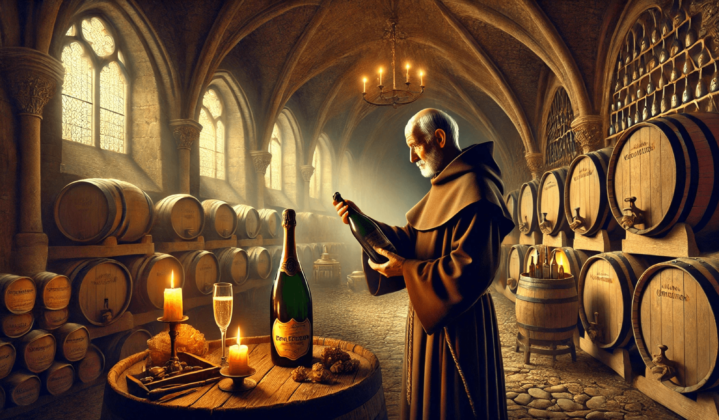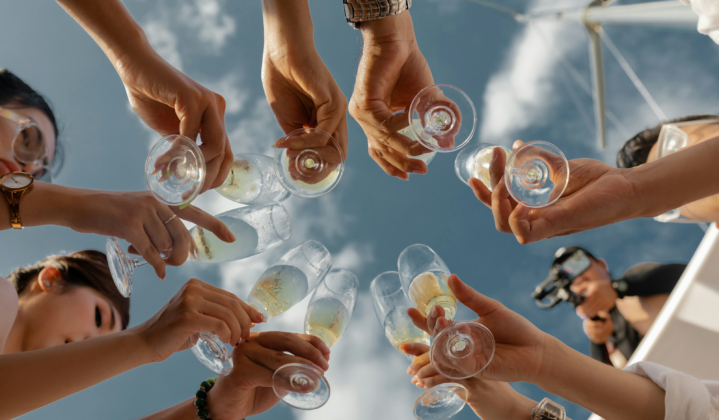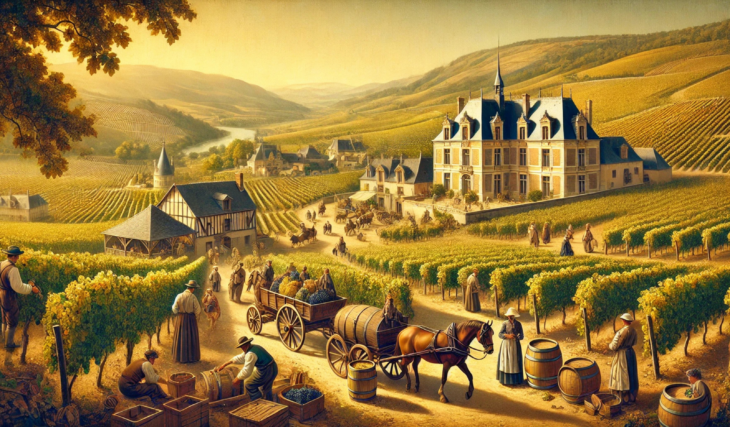The History of Champagne: From Dom Pérignon to Global Domination
How Did Champagne Begin? The Accidental Discovery
Champagne’s story is one of serendipity and innovation. In the 5th century, Romans first planted vineyards in the Champagne region of France, drawn by its unique terroir. By the Middle Ages, monks were cultivating vines, producing still wines that became prized throughout France. However, it wasn’t until the 17th century that the effervescent version of Champagne we know today was born—by accident.
The region’s cold climate caused fermentation to pause during winter, only to restart in spring when temperatures rose. This secondary fermentation trapped carbon dioxide in the bottle, creating bubbles. At first, winemakers saw this as a flaw, as bottles would often explode under the pressure. Over time, however, vintners realized they had stumbled upon something extraordinary, leading to the refinement of techniques that turned the once-unexpected effervescence into a celebrated characteristic.
Dom Pérignon: The Father of Champagne
 Dom Pierre Pérignon, a Benedictine monk from the Abbey of Hautvillers, played a pivotal role in refining Champagne production. His meticulous approach to winemaking involved blending different grape varieties to create a more balanced and complex wine. He also worked on strengthening bottles to withstand the internal pressure of carbonation and improving corking techniques to prevent leakage.
Dom Pierre Pérignon, a Benedictine monk from the Abbey of Hautvillers, played a pivotal role in refining Champagne production. His meticulous approach to winemaking involved blending different grape varieties to create a more balanced and complex wine. He also worked on strengthening bottles to withstand the internal pressure of carbonation and improving corking techniques to prevent leakage.
Although he did not invent sparkling wine, his contributions significantly enhanced Champagne’s quality and stability. His famous phrase, “Come quickly, I am tasting the stars!”—though likely apocryphal—reflects the enchantment that Champagne continues to evoke. His legacy lives on in the Dom Pérignon brand, which remains synonymous with prestige and luxury.
Christopher Merrett: The English Connection
While the French refined the art of Champagne, an English scientist named Christopher Merrett documented the process of adding sugar to still wines to induce secondary fermentation in 1662—predating Dom Pérignon’s work. This process, now known as the méthode champenoise, was instrumental in the development of Champagne as a sparkling wine.
England’s advancements in glassmaking were equally crucial. English glassmakers produced stronger bottles using coal-fired furnaces, making it possible to safely contain the intense pressure of carbonation. Without these innovations, Champagne production might never have evolved into the controlled and consistent process it is today.
How Old Is Champagne?
While vineyards in Champagne date back to Roman times, the sparkling wine we know today emerged in the late 1600s. Winemakers in the region spent decades refining their methods, learning how to manage carbonation, prevent bottle explosions, and produce a consistent product.
By the 18th and 19th centuries, Champagne houses had perfected the méthode champenoise, ensuring that every bottle delivered the signature bubbles and crispness. Today, Champagne continues to evolve, with modern techniques enhancing both its production and quality.
How Did Champagne Become Popular?
 Champagne’s ascent to prominence was largely fueled by its association with French aristocracy. In the 18th century, it became the drink of choice at royal courts, symbolizing wealth, refinement, and celebration. The coronations of French kings in Reims further cemented Champagne’s status as a drink fit for royalty.
Champagne’s ascent to prominence was largely fueled by its association with French aristocracy. In the 18th century, it became the drink of choice at royal courts, symbolizing wealth, refinement, and celebration. The coronations of French kings in Reims further cemented Champagne’s status as a drink fit for royalty.
By the 19th century, improvements in production, transportation, and marketing allowed Champagne to reach international markets. Champagne houses like Moët & Chandon, Veuve Clicquot, and Louis Roederer played a key role in expanding its global presence. Its popularity surged as it became the preferred drink for celebrations, from weddings to sporting victories, solidifying its legendary status.
Why Is Champagne Called the King of All Wines?
Champagne has long been associated with royalty and grandeur. French kings were crowned in Reims, at the heart of the Champagne region, and celebrated their victories and coronations with this effervescent drink. The association with aristocracy made Champagne a symbol of luxury and exclusivity, an image that persists to this day.
Over time, Champagne’s reputation extended beyond the royal courts. As production techniques improved and global demand grew, it became the drink of choice for moments of success and festivity. From ship launchings to New Year’s celebrations, Champagne’s presence in major events earned it the title “The King of All Wines.”
The Art of Champagne Sabering
 Champagne sabering, or sabrage, is a dramatic method of opening a Champagne bottle using a saber. This tradition dates back to the Napoleonic era when cavalry officers would use their swords to slice open bottles in celebratory displays. The technique involves striking the bottle’s neck at the seam, causing the cork and glass collar to break away cleanly due to the internal pressure of carbonation.
Champagne sabering, or sabrage, is a dramatic method of opening a Champagne bottle using a saber. This tradition dates back to the Napoleonic era when cavalry officers would use their swords to slice open bottles in celebratory displays. The technique involves striking the bottle’s neck at the seam, causing the cork and glass collar to break away cleanly due to the internal pressure of carbonation.
Though primarily a spectacle, sabering remains a celebrated ritual at prestigious events. Specialized Champagne sabers are crafted for this purpose, ensuring a smooth and precise cut. While skill and confidence are required, sabering adds an element of theatricality to Champagne service, honoring its rich heritage and the artistry behind its enjoyment.
Champagne’s Global Domination
Champagne has transcended its French origins to become a global symbol of luxury and celebration. No longer limited to aristocracy, it is now a staple at major events worldwide, from the Oscars to the Olympics. The industry exports millions of bottles annually, with the United States, Japan, and the United Kingdom among its largest markets.
The success of Champagne is largely due to the efforts of leading houses that have carefully cultivated their brands. Innovations in marketing, such as Veuve Clicquot’s introduction of remuage (riddling), ensured consistent quality and clarity. Moët & Chandon pioneered large-scale production, making Champagne more accessible while maintaining its elite status. Today, names like Dom Pérignon, Krug, and Laurent-Perrier set the gold standard for sparkling wine.
When Was the First Prestige Champagne Introduced?
The first prestige Champagne, Louis Roederer’s Cristal, was created in 1876 for Russian Tsar Alexander II. Crafted from the finest grapes and bottled in a distinctive flat-bottomed bottle, Cristal set the precedent for luxury Champagnes.
This concept inspired other high-end Champagne labels, including Dom Pérignon and Krug, to produce their own prestige cuvées. Today, these premium offerings represent the pinnacle of Champagne craftsmanship, reserved for those seeking the ultimate indulgence.
Champagne’s history is as rich and effervescent as the drink itself. From its accidental discovery to its status as the ultimate symbol of celebration, Champagne continues to captivate and delight connoisseurs worldwide.
Champagne: A Timeless Celebration
From its accidental beginnings to its place as the ultimate symbol of luxury and festivity, the history of Champagne is a story of innovation, tradition, and craftsmanship. It has graced royal courts, marked historic victories, and become a tradition in celebrations around the world.
At California Champagne Sabers, we honor this legacy by offering expertly crafted Champagne sabers and a curated selection of Champagne, ensuring every celebration is both elegant and unforgettable. More than just a drink, Champagne embodies joy, achievement, and the art of living well. With every bottle opened and every sabered cork sent flying, its rich heritage continues to shine, ensuring that its sparkle never fades.
FAQs
Has Champagne Always Been Clear?
No, early Champagnes were often cloudy due to sediment left from fermentation. The invention of remuage (riddling) by Madame Clicquot in the early 19th century allowed for the removal of sediment, resulting in the crystal-clear Champagne we enjoy today.
Has Champagne Always Been Dry?
Champagne was originally much sweeter than today’s varieties. In the 19th century, it was common for Champagne to contain significant residual sugar. The trend toward drier styles began with the introduction of brut Champagne in the 1840s, catering to evolving consumer preferences.
How Was Champagne Discovered by Mistake?
Champagne’s effervescence was originally an accident. In the 17th century, winemakers in the Champagne region of France struggled with cold winters that would halt fermentation prematurely. When temperatures rose in the spring, fermentation resumed inside the bottles, creating carbonation. This unintended second fermentation led to the sparkling quality of Champagne. While early winemakers considered the bubbles a flaw, the phenomenon was later refined and embraced, with Dom Pérignon and others playing key roles in perfecting the process.
Do the Grapes for Champagne Only Come from the Champagne Region?
Yes, authentic Champagne can only be made from grapes grown in the Champagne region of France. The Appellation d’Origine Contrôlée (AOC) regulations strictly define the boundaries of the region and the grape varieties that can be used—primarily Chardonnay, Pinot Noir, and Pinot Meunier. Sparkling wines made outside this region, even if produced using the same method, cannot legally be called Champagne.
Is Champagne a Protected Term?
Yes, Champagne is a legally protected term under European law and international agreements. Only sparkling wine produced in the Champagne region of France, following the traditional Méthode Champenoise, can be labeled as Champagne. This protection is enforced through treaties like the Madrid Agreement and the European Union’s Protected Designation of Origin (PDO) system. Many countries, including the EU and the US (with exceptions for certain grandfathered producers), recognize this designation to prevent misuse of the term.
